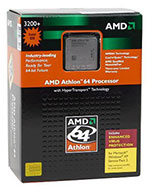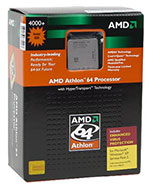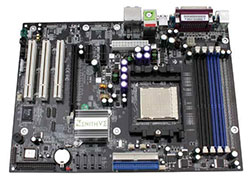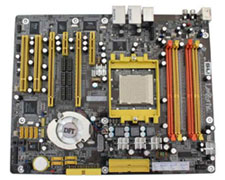Buyer's Guide: Mid-Range to High-End, May 2005
by Jarred Walton on May 23, 2005 5:30 PM EST- Posted in
- Guides
AMD Recommendations
AMD Processors
We covered the major differences between all of the currently shipping processor cores recently, and if you're not familiar with the various models, we would suggest that you give that a read. AMD arguably provides the best computing experience, both at the low end, the high end, and everything in between. However, their processor naming scheme can get a bit confusing, and especially the less experienced shoppers could end up with the wrong processor if they simply went by model numbers. There are no less than six currently shipping Athlon 64 3200+ chips, but we're only recommending one or two of those at present. Make sure that you get the right one!AMD Mid-Range Recommendation
Processor: Athlon 64 3200+ 90nm (Retail) - Winchester core
Price: $190 Shipped
The 3200+ remains to be the best option for socket 939, if you're trying to cut costs, yet still maintain a reasonable performance level. 2.0 GHz makes it 11% faster than the 3000+ and 9% slower than the 3500+. Although, the Winchester/Venice cores actually outperform Newcastle slightly clock for clock, so the 3500+ Newcastle may only be a few percent faster in certain applications (games, mostly). The 3000+ costs $146, and overclockers may be tempted to go that route rather than spend the extra $44. If you get a good motherboard and RAM for overclocking, the 3000+ may actually reach 2.5+ GHz, but it will require a 280+ MHz CPU bus speed compared to 250+ MHz for the 3200+. Depending on your overclocking skill, the 3200+ will probably get you farther than the 3000+. If you want to add SSE3 support, the Venice [RTPE: ADA3200BPBOX] cores cost an additional $20 relative to their Winchester [RTPE: ADA3200BIBOX] counterparts. SSE3 might help in certain encoding applications, and $20 isn't a major price difference, so it's definitely worth a thought. For now, we'll save the money for use elsewhere.
AMD High-End Recommendation
Processor: Athlon 64 4000+ 90nm (Retail) - San Diego core
Price: $507 Shipped
While the FX-55 remains the top-performing 939 part, we expect the new 90nm 4000+ [RTPE: ADA4000BNBOX] to give it a run for the money, particularly with overclocking. You may not be able to find the retail chips on sale right now, in which case, an OEM CPU is an option - overclockers are probably going to add a high-end HSF like the Zalman 7000 or Thermalright XP90 anyway. Some people feel that the retail chips are still a better choice for the improved warranty, and anecdotes of better overclocking with retail parts can be found on many forums. We're not sure if retail parts are actually better overclockers, but it's difficult to pass up on the 3-year warranty for a mere $18 increase. As a less expensive alternative that will still offer more performance than the 3200+ and 3500+, the new 3700+ [RTPE: ADA3700BNBOX] is definitely worth considering. The maximum overclocked speed is likely to be very similar to the 4000+, and it's quite a bit cheaper at $339. If you don't intend to overclock, of course, go with the fastest CPU that you can reasonably afford.
AMD Motherboards
If this were a budget guide, there would be many other options that we would consider, including boards using the VIA K8T890 and ATI Radeon Xpress 200 chipsets. For Mid-Range and above, nForce 3 and 4 are still our preferred choice. nForce 3 is on the way out, along with AGP, but if you have a good quality AGP card that you want to keep, it's a reasonable upgrade choice. For new systems, however, we recommend nForce 4 boards. The main difference between our Mid-Range and High End boards is the support (or lack thereof) for NVIDIA's SLI technology.AMD Mid-Range Recommendation
Motherboard: Chaintech VNF4 Ultra
Price: $89 Shipped
Considering the price difference (almost $20), we can't justify the additional cost for most of the competing nForce 4 Ultra motherboards. The Chaintech board lacks Firewire support, and the documentation and manual may not be the greatest, but it's still a high-performing board at a budget price. The Ultra model adds support for RAID and SATA2 as well as 1000 MHz HyperTransport, so we feel that it's worth the extra $2 relative to the nForce 4X model. Biostar, ECS, and Foxconn offer similarly equipped motherboards at a slightly higher price, but there's little reason to recommend their boards over the Chaintech - features and quality are very similar between these manufacturers in our experience, so we'll go with whatever's cheapest.
If you want additional features, ASUS, DFI, Gigabyte, MSI, and a few others make more expensive boards, and they certainly aren't a bad choice. DFI's Ultra board in particular is interesting, as it includes two physical PCIe X16 slots. While DFI doesn't ship an SLI connector and it may or may not be possible to mod the Ultra chip into an SLI chip, the board can still run dual graphics cards for multi-monitor support. DFI's boards also offer improved voltage ranges, which can help the overclockers, especially with RAM like the OCZ VX. Higher voltages mean more heat, which generally means more noise, so it's not something that everyone will appreciate. Still, most of these boards are at least $40 more than the Chaintech, so unless you really want the additional features, it's not worth the money. The nicer boards are also very close in price to some of the SLI boards, so at that point, you may as well go all the way to our High-End recommendation.
AMD High-End Recommendation
Motherboard: DFI LANPARTY UT nF4 SLI-DR
Price: $177 Shipped
For the high-performance enthusiast, SLI is the current crème de la crème, so an SLI motherboard is a must. The DFI Platinum board was co-winner of our Gold Editor's Choice award, and the differences between the UT and the "full version" are relatively minor. The UT doesn't include quite as many accessories, and the main omission is the front panel box and 5.1 audio instead of 7.1 audio; it also costs about $20 less. We don't feel that either of those features is really necessary, so we stuck with the standard model. The included Karajan sound module actually does quite well, so we don't see much need to purchase an add-in sound card for most users. The one issue worth mentioning on the DFI boards is that running with ultra-high voltages (using the 3.5V jumper) seems to cause some problems. That's only a concern for OCZ VX and Mushkin Redline users, really, and if you keep the voltage at stock you should be fine.
Honestly, all four SLI motherboards that we tested in our SLI Roundup (ASUS A8N Deluxe, Gigabyte GA-K8NXP-SLI, DFI LanParty SLI-DR, and MSI K8N Neo 4 Platinum SLI) are decent. The MSI board offers some great features, including the Sound Blaster 24-bit Live onboard audio. Unfortunately, we have recently discovered some performance issues when using the board with 90nm processors, so until MSI can release a BIOS update that addresses the issue, we would avoid the board. ASUS separates the two X16 slots by a larger margin, which should offer slightly better cooling for the top slot. However, it's a non-standard layout, and that could present problems in the future. We've already covered DFI, and Gigabyte has their "everything plus the kitchen sink" design. All four manufacturers are now offering "lite" versions of their SLI boards with reduced feature sets and prices, and in many cases, the missing features won't be missed. You can see the full list of SLI motherboards in our Pricing Engine. EPoX and Biostar also make SLI boards now, but we have not tested them, so we really can't comment on them other than to say they exist.
Update: After this Guide was initially written, it came to light that the MSI boards are having problems with 90nm parts. The MSI Neo4 SLI was our original high-end pick, but we changed that out after the new information. Sorry for the confusion!














60 Comments
View All Comments
Tujan - Tuesday, May 24, 2005 - link
Err a,thanks for reply..Calin.bummer when I do that.
Garyclaus16 - Tuesday, May 24, 2005 - link
All this article tells me is that my once 'bleeding edge' [939 Athlon64 3200+]system is now merely a mid range PC...save for my pqi turbo 2-2-2-5 :PStill...I am sad...I need to save up another 2k now for later this year. > :(
Tujan - Tuesday, May 24, 2005 - link
Thanks for reply Chris..Yeah Ive followed a few stories about the VIA Edens. Just hovering around 1 GHz. With single PCI slot.They too,have onboard graphics. Like pull that off , keep onboard sound maybe,...
Certainly limiting themselves with that kind of choice.Then Im not what that is suppose to reach. Two PCI-e slots at minimum for me.But this sends the engineers back to work.
Most vendors Iv seen include the graphics onto the mini-atx motherboards. MSI has an mini-atx w/o graphics ,..775.But isn't seen at vendors. Situation with the power,could make do with feature set of 915..945,955/Nvidias on mini-atx(s),.Since the lan is onboard.Might consider having maybe single Sata as well.
Not like being able to see clearly now...""I can see clearly now the rain is gone""..:)
Weird how we will see magic in closed black box embedded solution before we have that choice.
ProviaFan - Tuesday, May 24, 2005 - link
I agree with #34 for the most part, but anyone heavily into digital photography (whether with DSLR or scanned film) knows that it is very easy to exceed 1GB with Photoshop and a few images with some adjustment layers and layer masks (not to mention that my PC is general purpose and I usually have other stuff going in the background as well).stickx - Tuesday, May 24, 2005 - link
quoted from the guide: "long-time favorite, the OCZ Rev. 2 Platinum. While the price increase is quite drastic, it's worth mentioning that this same RAM cost as much as $275 just a few months back. It uses Samsung TCCD memory blanks"Unfortunately OCZ is no longer using TCCD memory in this product. This has been verified on several forums in xtremesystems.org and in dfi-street.com where people have removed the heat spreaders to find chips other that TCCD. I think you need to update your guide for this info.
OrSin - Tuesday, May 24, 2005 - link
Damn people get off thier backs. It a damn guide. Make all the choices you. They are giving thier recommondation, they are not give you ever fcking choice under the sun. No guide can have everyones choice.And ars, I don't know what planet your from but if you think epox is even near Asus or MSI in quality then then you full of it. If i saw any sit say Exop is better then ASUS, then I would stop reading them. Better then chaintech ost likely then not the top tier guys.
And for the record I play alot games and have noticed no improvement with 2GB of 1GB or memory.
Don know what you do thet 2GB is needed. Now I'm not saying you can;t find a way to use more then 1GB, but how many people actually do and on a regular bases.
Pythias - Tuesday, May 24, 2005 - link
When you guys refer to response time, is thet grey-to-grey, black-white-black, or total response time?MrOblivious - Tuesday, May 24, 2005 - link
Supposedly the issue with MSI NEO4 boards and 90nm chips has been fixed:http://forum.msi.com.tw/index.php?topic=80384.0
arswihart - Tuesday, May 24, 2005 - link
Kris - so you are now saying all mobo makers are essentially equal in terms of support, upgrades, MTBF (bad caps excuse is dead now since they all use good/great quality caps). So what's left to make me choose Asus/MSI? If you are saying reputation, I can just direct you to the forums, their boards are no better or worse than any of the competition. If you are recommending based on sales, thats just dumb.ceefka - Tuesday, May 24, 2005 - link
#1 I don't know how the onboard will handle sound in games, but I'd count on it to do that on the level it is built, i.e. no better than it will play a CD or DVD. It is however safe to say that onboard will definately not work for (semi)professional audio on a PC.I always thought that any realtime sound effects were handled by the CPU, unless you have a dedicated DSP-card or multiples thereof which gamers seldom do ;-)
Jarred: "anyone who doesn't intend to do any recording of audio" and what about those that do? I do read a lot about DAW's on the net, but have to get back to AT regularly to get a the details straight.
What do you make of this? http://www.rme-audio.com/english/techinfo/nforce4_...
With the Thonex audio stress test file (downloadable from http://www.adkproaudio.com/downloads.cfm), including memory-intensive data communication via samples/VSTis, and used with Cubase SX/Nuendo 2/3, soundcard latency has to be increased to approx. 2048 samples buffer latency setting with the NF4 to receive glitch-free audio recordings whereas with the NF3, and equivalent software/hardware/soundware equipment, the minimum latency can be significantly reduced (some 128-256 samples). Likewise, cpu load values are significantly higher with the NF4 than with the NF3 ditto - based on exactly the same audio stress test files and equivalent hardware peripherals.
The Thonex could be nice for your next high end guide when the dualcores are out.